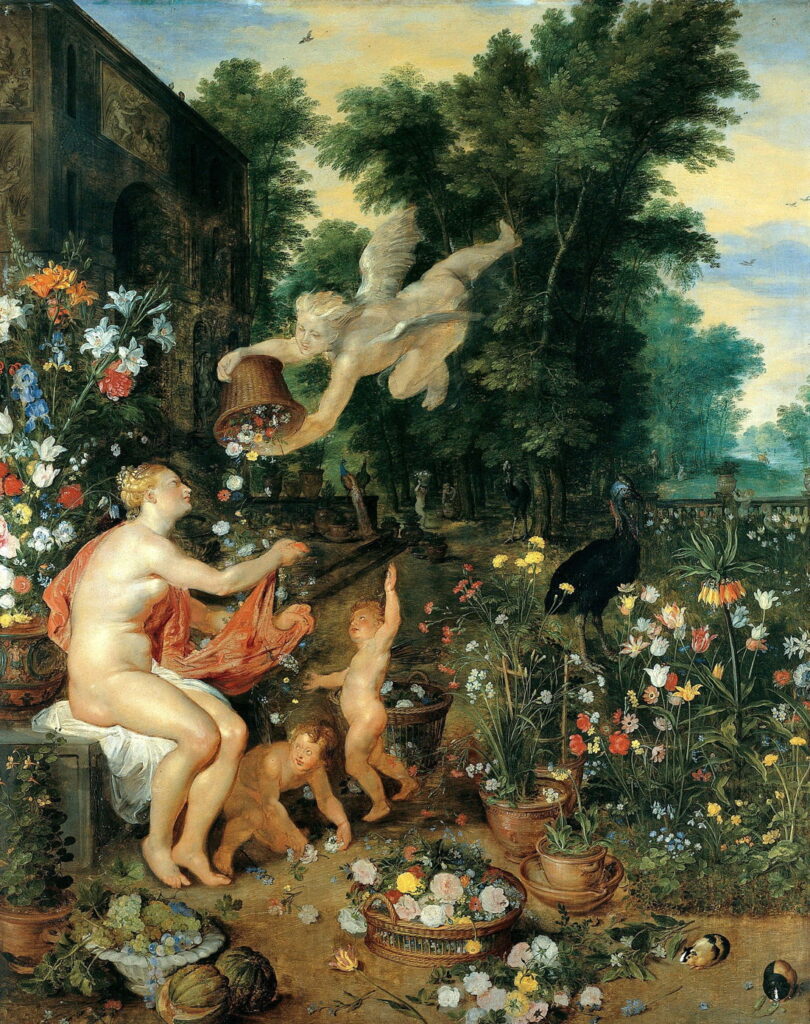Reading visual art: 81 Language of flowers A

In many European cultures flowers have developed into a visual language, in which particular species have a meaning that often isn’t obvious from their appearance. Naturally this has varied across different parts of Europe, and changed over time. In the Renaissance, my main concern in this article, associations come either from classical myth or Christian traditions, but when the language of flowers was revived by the Pre-Raphaelite artists in the middle of the nineteenth century, British folk traditions were added, as I’ll consider in tomorrow’s article.
Inevitably, the classical Roman goddess of Spring, Flora, brought with her some of the most extensive visual essays on the language of flowers, starting with Sandro Botticelli’s huge tempera masterpiece Primavera (Italian for Spring the season).
Sandro Botticelli (Alessandro di Mariano di Vanni Filipepi), Primavera (Spring) (c 1482), tempera on panel, 202 x 314 cm, Galleria degli Uffizi, Florence. Wikimedia Commons.
Botticelli’s painting is dominated by a series of mythological figures who tell its story. From the right, these are:
Zephyrus, who is borne on wings and grasps the body of
Chloris, who looks back in fright at Zephyrus, and from whose mouth a chain of plants emerges;
Flora, who is dressed in a robe bearing images of many different flowering plants, wears a garland of flowers in her hair, and appears to be casting flowers from within her robe,
Venus, who appears pregnant, and holds her right hand up in greeting or blessing,
Cupid (above Venus), who is about to loose a flaming arrow from his bow, and is borne on wings,
The Three Graces, Aglaea, Euphrosyne, and Thalia, linked by their hands, the nearest (with her back to the viewer) being the target of Cupid’s arrow, and looks at
Mercury, who holds his caduceus up to quell a small group of dark clouds, but faces away to the left, looking up at those clouds.
Sandro Botticelli (Alessandro di Mariano di Vanni Filipepi), Primavera (Spring) (detail) (c 1482), tempera on panel, 202 x 314 cm, Galleria degli Uffizi, Florence. Wikimedia Commons.
Chloris is almost superimposed on Flora. This is a direct reference to what is probably the central literary source for this painting, Ovid’s lines in his Fasti, covering the day of 3 May, which may have been transmitted to Botticelli through the contemporary Ovidian poet Poliziano (Angelo Ambrogini, 1454-1494), who like the artist enjoyed the patronage of the Medicis. Ovid’s lines explain how Zephyrus raped and then made a bride of the nymph Chloris, who then metamorphosed into Flora. Botanists have apparently identified more than 130 different species, sufficient to keep the floral linguist busy for years.
Jan Brueghel the Elder (1568–1625) and Peter Paul Rubens (1577–1640), Flora and Zephyr (c 1618), oil on panel, 136 x 109 cm, Schloss Mosigkau, Dessau-Roßlau, Germany. Wikimedia Commons.
Over a century later, in about 1618, Jan Brueghel the Elder and the young Peter Paul Rubens joined forces to paint their Flora and Zephyr. The fruit of this collaboration has many similarities to their better-known Five Senses series from the same time. Flora sits naked, collecting flowers dropped into a red sheet by an airborne Zephyrus, with two putti assisting. In addition to the rich floral display are pairs of birds and animals, including peacock and peahen, and guinea pigs in the right foreground. I’m not aware of anyone who has compiled a flora for this painting yet.
Just over a decade later, Nicolas Poussin painted his masterpiece The Empire of Flora (also known as The Realm of Flora) (1631); he had already painted The Triumph of Flora, a larger work with more figures and a very different scene, around 1627, which I won’t consider here.
Nicolas Poussin (1594–1665) The Empire of Flora (1631), oil on canvas, 131 × 181 cm, Gemäldegalerie Alte Meister, Desden, Germany. Wikimedia Commons.
The whole painting is set in a garden, with trees in the left background, a flower-laden system of pergolas, a large water feature, and dancing putti. In this are a series of well-known characters, several with classical floral associations, from the left:
a herm representing Priapus, his phallus wreathed in the greenery of gardens and fertility;
Ajax, falling on his sword and his spilled blood turning not into the usual purple hyacinth but a white carnation;
Narcissus and Echo, the former enraptured by his own reflection, with Echo gazing longingly at him, and the narcissus flower;
Clytie, who fell in love with Apollo and pined away into the sunflower or heliotrope;
Apollo in his sun chariot, with a band containing the signs of the zodiac;
Flora herself, presiding over her floral empire;
Hyacinthus, killed by his own discus for falling in love with Apollo then turned into the hyacinth flower, and Adonis, fatally wounded when hunting and turned into the anemone;
Smilax and Crocus, unrequited homosexual lovers, who were turned into saffron and rough bindweed flowers;
Cupid, with his quiver.
To date, all efforts to produce a coherent narrative of narratives have failed in one way or another. Although many of the individual stories are drawn from Ovid’s Metamorphoses, not all are. Although many involve death and metamorphosis into flowers, not all do. The stories don’t chain together in any way, nor do they have any common more contemporary link with literature re-telling those stories.
Christian floral associations were less exuberant.
Hans Memling (c 1430-1494), Flowers in a Jug (c 1485), oil on panel (verso of Portrait of a Young Man Praying), 29.2 x 22.5 cm, Museo Nacional Thyssen-Bornemisza, Madrid, Spain. Wikimedia Commons.
Hans Memling painted these Flowers in a Jug on the back of a panel bearing a portrait of a young man praying, in about 1485. It’s thought that this was part of a diptych or triptych, and could have formed its back cover when folded. His choice of jug and flowers confirms its religious nature: Christ’s monogram is prominent on the body of the jug, and each of the flowers has specific references. Lilies refer to the purity of the Virgin Mary, irises to her roles as Queen of Heaven and in the Passion, and the small aquilegia flowers are associated with the Holy Spirit.
Ambrosius Bosschaert (1573–1621), Flower Still Life (1614), oil on copper, 30.5 x 38.9 cm, J. Paul Getty Museum, Los Angeles, CA. Wikimedia Commons.
Ambrosius Bosschaert painted this Flower Still Life in oil on copper in 1614. At first its eclectic mixture of different flowers and flying insects might appear haphazard. However, the flowers include carnation, rose, tulip, forget-me-nots, lilies of the valley, cyclamen, violet and hyacinth, which could never (at that time) have been in bloom at the same time. The butterflies, bee and dragonfly are as ephemeral as the flowers around them, suggesting that this has an underlying vanitas theme.



